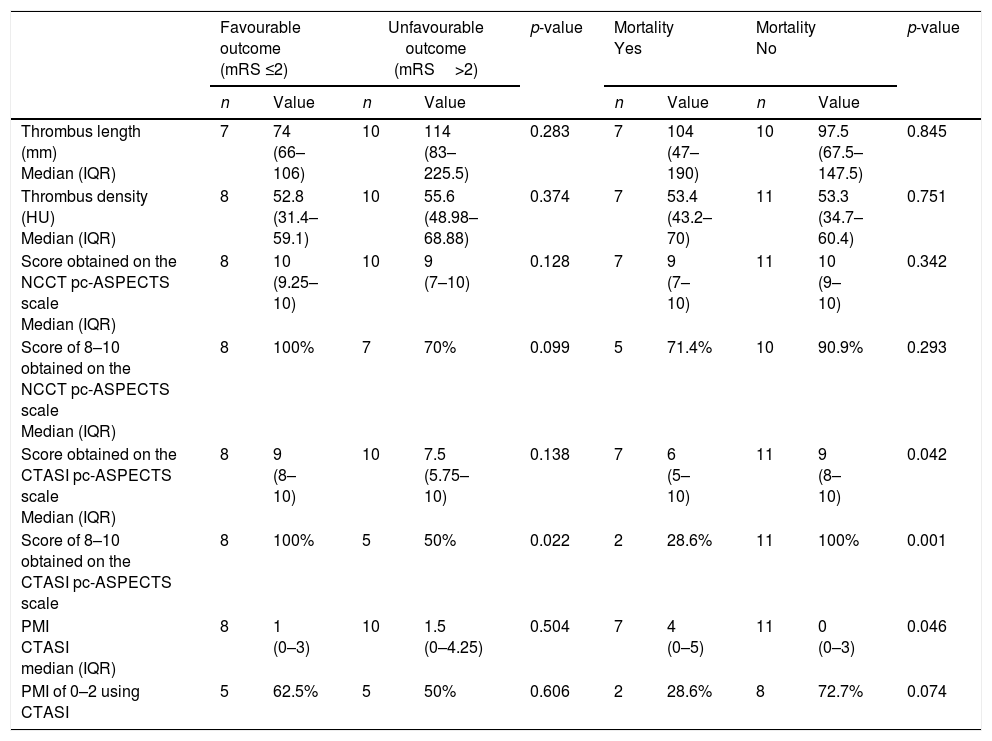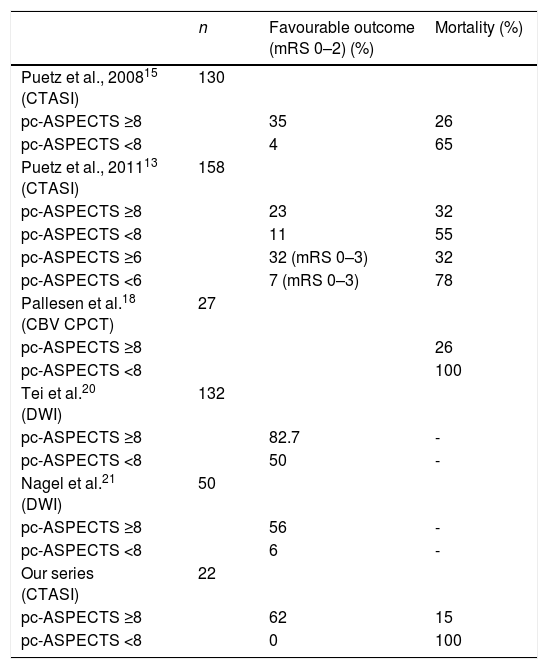Endovascular treatment with mechanical thrombectomy devices demonstrated high recanalization rates but functional outcome did not correlate with high rates of recanalization obtained. Patient selection prior to the endovascular treatment is very important in the final outcome of the patient. The primary aim of our study was to evaluate the prognostic value of posterior circulation Alberta Stroke Program Early CT Score (pc-ASPECTS) and Pons-Midbrain Index (PMI) scores in patients with Basilar Artery Occlusion (BAO) treated with successful angiographic recanalization after mechanical thrombectomy.
MethodsRetrospective single-centre study including 18 patients between 2008 and 2013 who had acute basilar artery occlusion managed with endovascular treatment within 24h from symptoms onset and with successful angiographic recanalization. The patients were initially classified into two groups according to clinical outcome and mortality at 90 days. For analysis we also divided patients into groups based on pc-ASPECTS (≥8 vs. <8) and PMI (≥3 vs. <3) on non-contrast CT (NCCT) and CT Angiography Source Images (CTASI). Imaging data were correlated to clinical outcome and mortality rate.
ResultsCTASI pc-ASPECTS, dichotomized at <8 versus ≥8, was associated with a favourable outcome (RR: 2.6; 95% CI: 1.3–5.2) and a reduced risk of death (RR: 6.5: 95% CI: 7.8–23.3). All patients that survived and were functionally independent had pc-ASPECTS score ≥8. None of the 5 patients with CTASI pc-ASPECTS score less than 8 survived.
ConclusionPC-ASPECTS on CTASI is helpful for predicting functional outcome after BAO recanalization with endovascular treatment. These results should be validated in a randomised controlled trial in order to decide whether or not to treat a patient with BAO.
El tratamiento endovascular con dispositivos de trombectomía mecánica demostró altos índices de recanalización, si bien el resultado funcional no guardó relación con los altos índices de recanalización obtenidos. La selección de los pacientes previa al tratamiento endovascular es muy importante en el resultado final de estos pacientes. El objetivo principal de nuestro estudio fue hacer una valoración del valor pronóstico de la escala ASPECTS (Escala Precoz por TC del Programa de ACV de Alberta) y del índice puente-mesencéfalo (IPM) en pacientes con oclusiones de la arteria basilar (OAB) sometidos, con éxito, a recanalización angiográfica tras trombectomía mecánica.
MétodosEste estudio retrospectivo de un único centro incluyó 18 pacientes entre los años 2008 y 2013 con oclusiones de la arteria basilar que fueron sometidos a tratamiento endovascular dentro de las 24 horas siguientes al inicio de los síntomas y con una exitosa recanalización angiográfica. Inicialmente, los pacientes fueron clasificados en dos grupos según el resultado clínico y la mortalidad a los 90 días. Para el análisis, los pacientes también fueron divididos en grupos de imágenes utilizando, para ello, la escala ASPECTS-CP (≥8 vs. <8) y el IPM (≥3 vs. <3) mediante tomografías computarizadas sin contraste (TCSC) e imágenes fuente de la angio-TC (IFATC). Los datos de las imágenes se compararon tanto con los resultados clínicos como con la tasa de mortalidad.
ResultadosLa escala ASPECTS-CP mediante IFATC, dicotomizada a <8 vs. ≥8, se asoció a un resultado favorable (riesgo relativo [RR]: 2,6; intervalo de confianza [IC] del 95%: 1,3–5,2), así como a un menor riesgo de mortalidad (RR: 6,5; IC del 95%: 7,8–23,3). La puntuación en la escala ASPECTS-CP de todos los pacientes que sobrevivieron y fueron funcionalmente independientes fue igual o superior a 8. Ninguno de los cinco pacientes con puntuaciones en la escala ASPECTS-CP mediante IFATC por debajo de 8 sobrevivió.
ConclusiónLa escala ASPECTS-CP mediante IFATC sirve de ayuda a la hora de predecir el resultado funcional tras recanalización de la OAB mediante tratamiento endovascular. Estos resultados deberían ser validados en un ensayo controlado aleatorizado para decidir si tratar, o no, a un paciente con OAB.











